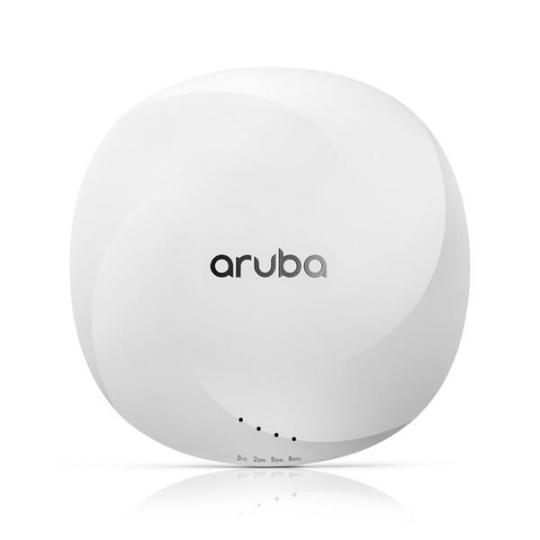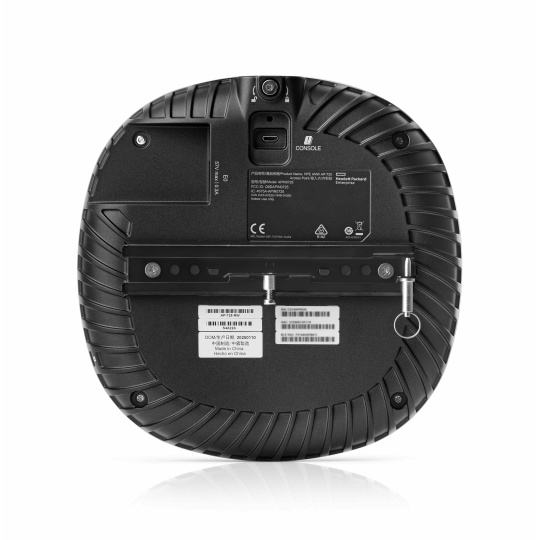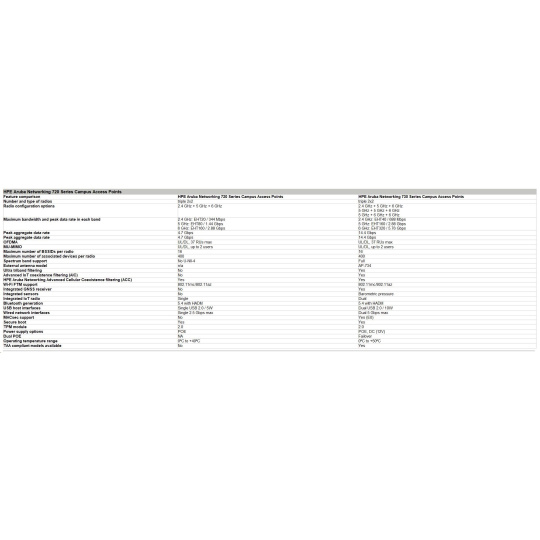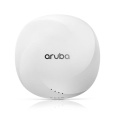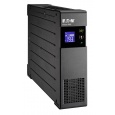HPE Aruba Networking AP-725 (RW1) Tri Radio 2x2 Wi-Fi 7 Internal Antennas Campus Access Point
HPE Aruba Networking AP-725 (RW1) Tri Radio 2x2 Wi-Fi 7 Internal Antennas Campus Access Point
HPE Aruba Networking AP-725 (RW) Tri Radio 2x2 Wi-Fi 7 Internal Antennas Campus Access Point
Designed to deliver cutting-edge Wi-Fi performance, the HPE Aruba Networking 720 Series Campus Access Points offer enterprises a cost-effective solution that meets the demand for fast, secure, high-performance connectivity. Leveraging the latest Wi-Fi 7 standard, these access points enhance security across both wired and wireless networks, support Internet of Things (IoT) devices, and provide accurate location-aware capabilities. HPE Aruba Networking Central helps drive efficient operations and provides AI-automation and machine learning (ML) insights for fine-tuned wireless connectivity across diverse environments. Like all the HPE Aruba Networking access points, this series is Wi-Fi CERTIFIED and includes a limited lifetime warranty for investment protection.
Key Features
- Wi-Fi 7 (802.11be) brings multilink operation (MLO) for channel aggregation, 4K QAM for higher throughput and lower latency, and the 6 GHz band for more than double the available capacity
- Three 2x2 MIMO radios provide triband coverage across 2.4 GHz, 5 GHz, and 6 GHz to deliver 4.7 Gbps maximum tri-band aggregate data rate
- Flexible integrated IoT radio can be configured for BLE or 802.15.4/Zigbee operation
- Conveniently powered by PoE (IEEE 802.3at)
- Fast 2.5 Gbps Ethernet connectivity
- AI-powered dynamic power save mode helps reduce energy use
Standard Features
AI-powered Wi-Fi 7
Managing Wi-Fi 7 access points is easier with HPE Aruba Networking Central, which provides intelligent automation, AI insights, and unified infrastructure management. The HPE Aruba Networking 720 Series Campus Access Points is supported by HPE Aruba Networking Wireless Operating System AOS-10.
More Capacity
The HPE Aruba Networking 720 Series Campus Access Points are designed to take advantage of every bit of available spectrum through three dedicated radios, which translates into high speeds, wider channels for multigigabit traffic, and less interference. Supporting up to 160 MHz wide channels, the series delivers up to 4.7 Gbps maximum triband aggregate data rate, using three 2x2 MIMO radios (2.4 GHz, 5 GHz, and 6 GHz).
Wi-Fi 7 for Faster Speeds, More Capacity
The Wi-Fi 7 standard (802.11be) extends the capabilities of Wi-Fi 6E, including the use of the 6 GHz band. New capabilities include multilink operation (MLO) for channel aggregation across different bands and failover, and 4096 QAM (4K QAM) modulation for higher peak data rates, and spectrum puncturing to avoid interference or incumbent users of the 6 GHz band.
Advantages of 6 GHz
Wi-Fi 7 takes advantage of up to 1200 MHz in the 6 GHz band for higher throughput and improved application performance. HPE Aruba Networking 720 Series Campus Access Points support up to seven 160 MHz channels or fourteen 80 MHz channels, enabling improved support of low-latency, bandwidth-hungry applications such as high-definition video and artificial reality/virtual reality applications. Only Wi-Fi 6E or Wi-Fi 7 capable devices can use the 6 GHz band so there is no interference or slowdowns due to legacy devices.
Device class support
HPE Aruba Networking 720 Series Campus Access Points with integrated antennas are part of the Low Power Indoor (LPI) device class. This fixed indoor-only class uses lower power levels and does not require an Automated Frequency Coordination service (AFC) to manage incumbent outdoor services, which is required for standard class access points.
Global readiness
While the need for more Wi-Fi capacity is recognized across the globe, countries are approaching 6 GHz differently. The HPE Aruba Networking 720 Series Campus Access Points are set up to automatically update regulatory rules once Wi-Fi 7 regulations have been approved and certified.
Extend the benefits of Wi-Fi 6
The HPE Aruba Networking 720 Series Campus Access Points are based on the 802.11be standard, which means that all its efficiency and security enhancements are also available on the 6 GHz band. Wi-Fi 6 features such as Orthogonal Frequency Division Multiple Access (OFDMA), BSS coloring are fully supported on HPE Aruba Networking Wi-Fi 6E and Wi-Fi 7 access points as well. Comprehensive Network Security
Advantages of OFDMA
This capability allows HPE Aruba Networking access points to handle multiple 802.11be capable clients on each channel simultaneously, regardless of device or traffic type. Channel utilization is optimized by handling each transaction through smaller subcarriers or resource units (RUs), which means that clients are sharing a channel and not competing for airtime and bandwidth.
Cost-effective, future-proof Wi-Fi 7
Leveraging AI-powered HPE Aruba Networking Central, the HPE Aruba Networking 720 Series Campus Access Points is an integral part of the HPE Aruba Networking Wi-Fi 7 access point portfolio. Built on the same high-performance Wi-Fi 7 platform as the HPE Aruba Networking 730 Series Campus Access Points, the HPE Aruba Networking 720 Series Campus Access Points offers a cost-effective solution by omitting high-end features such as 320 MHz channel bandwidth support, dual IoT radios, dual 10 Gbps ports, and MACsec support.
Wi-Fi o p t i m i z a t i o n:
Client optimization
The patented AI-powered HPE Aruba Networking Central ClientMatch technology reduces sticky client issues by steering a client to the access point where it receives the best radio signal. It steers traffic from the noisy 2.4 GHz band to the preferred 5 GHz or 6 GHz band depending on client capabilities. Also dynamically steers traffic to load balance access points to improve the user experience.
Automated Wi-Fi radio frequency management
To optimize the user experience and provide greater stability, HPE Aruba Networking AirMatch allows organizations to automate network optimization using machine learning. It provides dynamic bandwidth adjustments to support changing device density, enhanced roaming using an even distribution of Effective Isotropic Radiated Power (EIRP) to radios, and real-time channel assignments to mitigate co-channel interference.
Reduces interference
Unique HPE Aruba Networking Advanced Cellular Coexistence uses built-in filtering to automatically help minimize the impact of interference from cellular networks, distributed antenna systems (DAS), and commercial small cell or femtocell equipment.
Dynamic power save mode
Access points switch into a dynamic power save mode and automatically wake up at a schedule when connectivity demand arises, reducing power demands and saving money in alignment with the organization's sustainability initiatives.
Intelligent power monitoring (IPM)
For better insights into energy consumption, HPE Aruba Networking access points continuously monitor and report hardware energy usage. Unlike other vendors' access points, HPE Aruba Networking access points can also be configured to enable or disable capabilities based on available PoE power-ideal when wired switches have exhausted their power budget. Enterprises can deploy Wi-Fi 7 access points and update switching and power at a later if needed based on their actual usage.
Location-Aware Services
Indoor location shouldn't require guesswork or costly or complex overlay technologies. HPE Aruba Networking Wi-Fi 6, Wi-Fi 6E, and Wi-Fi 7 access points help organizations leverage their wireless investment to deliver indoor location capabilities everywhere.
As part of HPE Aruba Networking indoor location solutions, they serve as reference points for client devices and other technologies using fine time measurement.
Open Locate, an emerging standard that allows access points to share their location over the air and through cloud-based APIs, enables mobile devices to locate themselves and applications to support network analytics.
The HPE Aruba Networking 720 Series Campus Access Points support FTM 802.11az for sub-1 meter accuracy, which allows it to participate in a cluster of access points that also support Open Locate. By using anchor access points in that cluster, the HPE Aruba Networking 720 Series Campus Access Points can determine its location.
Access Points as Flexible and Secure IoT Platform
By combining the IoT radio with a zero-trust network framework, the HPE Aruba Networking 720 Series Campus Access Points can serve as flexible IoT platforms that bolster network security, provide coverage for a broad range of IoT devices, and helps reduce the need for network overlays just for IoT devices.
The HPE Aruba Networking 720 Series Campus Access Points includes an integrated Bluetooth 5.4 or 802.15.4 radio for Zigbee support to simplify deploying and managing IoT-based location services, asset tracking services, security solutions, and IoT sensors. There is also a USB host port to provide IoT connectivity to a wider range of devices.
These IoT capabilities allow organizations to leverage the access point as an IoT platform, which eliminates the need for an overlay infrastructure and additional IT resources and can accelerate IoT initiatives.
In addition, Target Wake Time (TWT) establishes a schedule for when clients need to communicate with an access point. This helps improve client power savings and reduces airtime contention with other clients, which is ideal for IoT.
Streamline IoT operations
HPE Aruba Networking Central IoT Operations dashboard unifies visibility of IT and OT infrastructure within the network health dashboard by extending network monitoring and insights to BLE, Zigbee, and other non-IP IoT devices. It helps streamline non-Wi-Fi device onboarding and data collection.
AI Client Insights
ML-based classification of all clients and IoT devices through HPE Aruba Networking Central Client Insights uses deep packet inspection to provide additional context and behavioral information that help ensure devices are receiving proper policy enforcement and continuously monitor for rogue devices.
Technology Partnerships
A broad ecosystem of technology partners provide interoperability for easier installations and operations, and certified solutions are available to help digital transformation and extend capabilities of network infrastructure.
Security built-in
The HPE Aruba Networking 720 Series Campus Access Points includes security capabilities such as:
WPA3 and Enhanced Open
Support for stronger encryption and authentication is provided via the latest version of WPA for enterprise-protected networks. Enhanced Open offers seamless new protection for users connecting to open networks, where each session is automatically encrypted to protect user passwords and data on guest networks.
WPA2-MPSK
MPSK enables simpler passkey management for WPA2 devices-should the Wi-Fi password on one device or device type change, no additional changes are needed for other devices.
Trusted Platform Module (TPM) For enhanced device assurance, all HPE Aruba Networking access points include an installed TPM for secure storage of credentials and keys, and boot code.
User and device authentication
Cloud-native network access control (NAC) provided by HPE Aruba Networking Central further simplifies how IT controls network access while providing a frictionless experience for end users. Global policy automation and orchestration enables IT to define and maintain global policies at scale with ease, using UI-driven, intuitive workflows that automatically translate security intent into policy design and map user roles for employees, contractors, guests, and devices to their proper access privileges.
Intrusion detection
HPE Aruba Networking Central utilizes the Rogue AP Intrusion Detection Service (RAPIDS) to identify and resolve issues caused by rogue APs and clients. Wired and wireless data are automatically correlated to identify potential threats, thereby strengthening network security and improving incident response processes by reducing false positives.
Web content filtering
Web Content Classification (WebCC) classifies websites by content category and rates them by reputation and risk score, enabling IT to block malicious sites to help prevent phishing, DDoS, botnets, and other common attacks.
Simple and secure access
To improve security and ease of management, IT can centrally configure and automatically enforce role-based policies that define proper access privileges for employees, guests, contractors, and other user groups-no matter where users connect on wired and WLANs. Dynamic segmentation eliminates the time-consuming and error-prone task of managing complex and static VLANs, ACLs, and subnets by dynamically assigning policies and keeping traffic secure and separated.
Seamless handoffs to cellular
Built on the technical foundations of Passpoint® and Wi-Fi Calling, HPE Aruba Networking Air Pass creates a roaming network across the HPE Aruba Networking enterprise customer footprint, extending cellular coverage and enhancing the visitor and subscriber experience to deliver a great experience for your guests while reducing costs and management overhead for DAS.
HPE Aruba Networking Wireless Operating System
Cloud-native HPE Aruba Networking Wireless Operating System AOS-10 is the distributed network operating system working with HPE Aruba Networking Central that acts as the control layer for HPE Aruba Networking APs and gateways.
With its flexible architecture, IT can deliver reliable and secure wireless connectivity for small offices, mid-sized branches, large campus environments, and remote workers.
Working in tandem with cloud-native HPE Aruba Networking Central, HPE Aruba Networking Wireless Operating System AOS-10 provides the WLAN management and control to deliver greater scalability, security, and AI-powered optimization. This reduces the processing required by on-site gateways for managing clients and access points, allowing enterprises to deploy fewer gateways even in large environments with thousands of access points and devices.
Flexible Operation and Management
Our unified access points can operate as stand-alone access points or with a gateway for greater scalability, security, and manageability.
Access points can be deployed using zero touch provisioning-without on-site technical expertise-for ease of implementation in branch offices and for remote work.
HPE Aruba Networking access points can be managed through HPE Aruba Networking Central, which provides a single pane of glass for overseeing every aspect of wired and wireless LANs, WANs, and SD-WAN. AI-powered analytics, end-to-end orchestration and automation, and advanced security features are built natively into the solution.
Simplified, Flexible Consumption
The HPE Aruba Networking 720 Series Access Points require HPE Aruba Networking Central subscription-based licenses, which are purchased on a per-device basis for APs and gateways. Licenses are available in 1-, 3-, 5-, 7-, and 10-year increments, making it easy to align requirements for AIOps, security, and other desired management features. HPE Aruba Networking Wireless Operating System AOS-10 is included in the subscription. Learn more about HPE Aruba Networking Central.
HPE Aruba Networking Wi-Fi Solutions
Wherever Wi-Fi is needed, HPE Aruba Networking Wi-Fi 7, Wi-Fi 6E, and Wi-Fi 6 access points are ready to provide fast, reliable, and secure coverage. Our access points provide broad network observability, improve mobile client coverage, optimize Wi-Fi bandwidth, and increase operational efficiencies with a choice of cloud or on-premises deployment options. Our portfolio includes Wi-Fi CERTIFIED indoor, outdoor, ruggedized, and remote Wi-Fi access points to address a wide range of enterprise use cases and price points, with solutions backed by a limited lifetime warranty.
As part of a full portfolio of Wi-Fi 7 access points, the HPE Aruba Networking 720 Series Campus Access Points offer a cost-effective way to deliver fast, resilient, and secure Wi-Fi 7 wireless access across campus networks. Supported by HPE Aruba Networking Central, they help deliver an AI-powered, security-first network.
HPE Aruba 720 vs 730 Series Access Points Comparison
HPE Aruba Networking 720 vs 730 Series Campus Access Points
| Feature | 720 Series | 730 Series |
|---|---|---|
| Number and Type of Radios | Triple 2x2 | Triple 2x2 |
| Radio Configuration Options | 2.4 GHz + 5 GHz + 6 GHz 5 GHz + 5 GHz + 6 GHz | 2.4 GHz + 5 GHz + 6 GHz 5 GHz + 6 GHz + 6 GHz |
| Max Bandwidth & Data Rate (Per Band) | 2.4 GHz: EHT20 / 344 Mbps 5 GHz: EHT80 / 1.44 Gbps 6 GHz: EHT160 / 2.88 Gbps | 2.4 GHz: EHT40 / 688 Mbps 5 GHz: EHT160 / 2.88 Gbps 6 GHz: EHT320 / 5.76 Gbps |
| Peak Aggregate Data Rate | 4.7 Gbps | 14.4 Gbps |
| OFDMA | UL/DL, 37 RUs max | UL/DL, 37 RUs max |
| MU-MIMO | UL/DL, up to 2 users | UL/DL, up to 2 users |
| Max BSSIDs per Radio | 16 | 16 |
| Max Associated Devices per Radio | 400 | 400 |
| Spectrum Band Support | No U-NII-4 | Full |
| External Antenna Model | n/a | AP-734 |
| Ultra Triband Filtering | No | Yes |
| Advanced IoT Coexistence (AIC) | No | Yes |
| Advanced Cellular Coexistence (ACC) | Yes | Yes |
| Wi-Fi FTM Support | 802.11mc / 802.11az | 802.11mc / 802.11az |
| Integrated GNSS Receiver | No | Yes |
| Integrated Sensors | No | Barometric pressure |
| Integrated IoT Radio | Single | Dual |
| Bluetooth Generation | 5.4 with HADM | 5.4 with HADM |
| USB Host Interfaces | Single USB 2.0 / 5W | Dual USB 2.0 / 10W |
| Wired Network Interfaces | Single 2.5 Gbps max | Dual 5 Gbps max |
| MACsec Support | No | Yes (E0) |
| Secure Boot | Yes | Yes |
| TPM Module | 2.0 | 2.0 |
| Power Supply Options | PoE | PoE, DC (12V) |
| Failover | NA | Dual PoE |
| Operating Temperature Range | 0°C to +40°C | 0°C to +50°C |
| TAA Compliant Models | No | Yes |
HPE Aruba Networking AP-725: Technical Specifications
Hardware Variants
-
Model: HPE Aruba Networking AP-725 (Internal antenna models)
Wi-Fi Radio Specifications
-
Access Point Type: Indoor, tri-radio (2.4 GHz, 5 GHz, 6 GHz), concurrent operation
-
MIMO: 2x2 on all bands (802.11be)
-
Max Data Rates:
-
2.4 GHz: 344 Mbps (EHT20)
-
5 GHz: 1.44 Gbps (EHT80)
-
6 GHz: 2.88 Gbps (EHT160)
-
-
Client Support: Up to 400 clients per radio, 16 BSSIDs per radio
Supported Frequency Bands
-
2.4 GHz: 2.400 to 2.4835 GHz ISM
-
5 GHz: U-NII-1 to U-NII-3/ISM (5.150 to 5.850 GHz)
-
6 GHz: U-NII-5 to U-NII-8 (5.925 to 7.125 GHz)
Radio Technologies
-
Standards: 802.11a/b/g/n/ac/ax/be
-
Modulations: BPSK to 4096-QAM
-
OFDMA: Up to 37 Resource Units (UL/DL)
-
Other Technologies: MRC, CDD, STBC, LDPC, TxBF, TWT, FTM
Antennas
-
Integrated Omni-Directional Antennas
-
2.4 GHz: 5.1 dBi
-
5 GHz: 5.4 dBi
-
6 GHz: 5.4 dBi
-
Combined Peak Gains: 3.8 dBi (2.4 GHz), 4.7 dBi (5 GHz), 4.9 dBi (6 GHz)
-
Interfaces
-
Ethernet (E0): RJ-45, 100/1000/2500BASE-T, PoE (802.3af/at)
-
USB (U0): USB 2.0 Type A, 5W output
-
IoT Radio: Dual-mode (BLE 5.4, Zigbee/802.15.4)
-
Security Slot: Kensington
-
Console Port: Micro-B USB
Power
-
Source: PoE (802.3af/at)
-
Max Consumption: 22.8W (with USB), 17.1W (without USB)
-
Idle Consumption: 7.0W
-
Deep-Sleep: 3.5W
Mounting
-
Mounting Bracket: Pre-installed, compatible with multiple mount kits
Mechanical
-
Unit Dimensions: 200 x 200 x 48 mm
-
Unit Weight: 910g
-
Shipping Dimensions: 267 x 251 x 83 mm
-
Shipping Weight: 1290g
Environmental
-
Operating Temp: 0oC to +40oC
-
Storage Temp: -25oC to +55oC
-
Transport Temp: -40oC to +70oC
-
Humidity: 5% to 95% (operating), 10% to 100% (storage), up to 95% (transport)
Reliability
-
MTBF: 1,720,000 hours (197 years at +25°C)
Regulatory
-
Compliance: FCC, ISED, CE, LVD, UL/IEC/EN 62368-1, EN60601-1-2
-
Plenum Rated: UL2043
-
Certifications: Wi-Fi 7, WPA2/WPA3, Enhanced Open, WMM, Agile Multiband
-
Model Number: APIN0725
Software
-
Minimum OS: AOS 10.7.2.0
Warranty
-
Coverage: HPE Aruba Networking hardware limited lifetime warranty
RF Performance Table (Excerpts)
-
2.4 GHz 802.11be EHT20:
-
MCS0 Tx: 18 dBm / Rx: -93.5 dBm
-
MCS13 Tx: 12 dBm / Rx: -56.5 dBm
-
-
5 GHz 802.11be EHT80:
-
MCS0 Tx: 18 dBm / Rx: -89.5 dBm
-
MCS13 Tx: 12 dBm / Rx: -53.0 dBm
-
-
6 GHz 802.11be EHT160:
-
MCS0 Tx: 18 dBm / Rx: -86.5 dBm
-
MCS13 Tx: 12 dBm / Rx: -50.0 dBm
-
